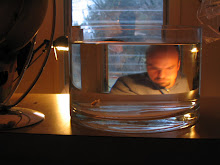A cold January Friday morning, glazed with a thin veneer of ice: pedestrians slip and slide as they navigate suddenly treacherous sidewalks, and seek shelter under the scrim of buildings and overhangs. A perfect time, in other words, to read up on Paleolithic cave art. Over a cup of coffee, then, I hunkered down with David Whitley's Cave Paintings and the Human Spirit, an engrossing defense of shamanistic interpretations of ancient rock imagery - and was delighted to see him quote, in a passage on the difficulty of writing about spiritual transformation, Thelonius Monk. "Writing about music," Monk once said, in an attempt to convey his disenchantment with music criticism, "is like dancing to architecture."
That's a memorable phrase - and yet even its abrupt logic can't quite convince many of us of the futility of trying, at least, to render one art in the terms of another. In fact, Whitley himself blithely disregards Monk's warning: on page 75, he gets interested in the tonal contrast between the paintings at Chauvet and those at Lascaux, and ultimately settles on a musical analog: Lascaux, he contends, "is a Beethoven symphony that wraps you up in its power and controls your emotions, moving you by its volume and force and majesty. The other is that single, flawless woman's voice singing a simply melody that you hear inadvertently." Well, then - take that, Monk. Whitley can read paintings in terms of music, and can then describe that relation in writing.
But, still, there's obviously some merit to Monk's contention. Critics have always wondered about the distances between the various arts, and artists have often proclaimed those gulfs to be untraversable (When Balanchine was asked what a new dance of his was "about," he supposedly liked to respond that "It is about 28 minutes"). Dances don't mean, in other words, in the same way that sentences do. And, in turn, one could surely say the same thing about parenting, and learning from one's child. This blog is based on an unspoken assumption that my relationship with Cleo can be somehow converted, effectively, into words and photos. If examined at all closely, though, such a pretense quickly begins to unravel.
And yet, at times I'm struck by the way in which our fragile marks - letters; numbers; symbols - can in fact convey experience in a deep and rich manner. A couple of weeks ago, on an equally wet day, I took Cleo to the Maryland Science Center. In the main play room, she was riveted by the pneumatic message tube, which allows kids to send brief messages or pictures of their own creation to a sibling or a parent (or to, as the case may be, a total stranger) at the othe end of the system. Again and again, Cleo drew delicate hearts and brief, emphatic messages of affection (Cleo [heart] you), and fired them off in my direction. And while I honestly felt, in opening the capsule each time, a rush of excitement and affection, I think that I also felt a true version of the sheer happiness that she was experiencing, as the sender. As a semiotician might say, the referent was passed from sender to recipient with little in the way of semantic degradation.
And so perhaps it's not all quite as futile as Monk imagined. Indeed, on a day like today, as we really do skate and skitter and unintentionally dance beneath the archiecture that looms above us, it almost seems as if it's possible to write about music, and parenthood, and even love with something more that total futility.





No comments:
Post a Comment